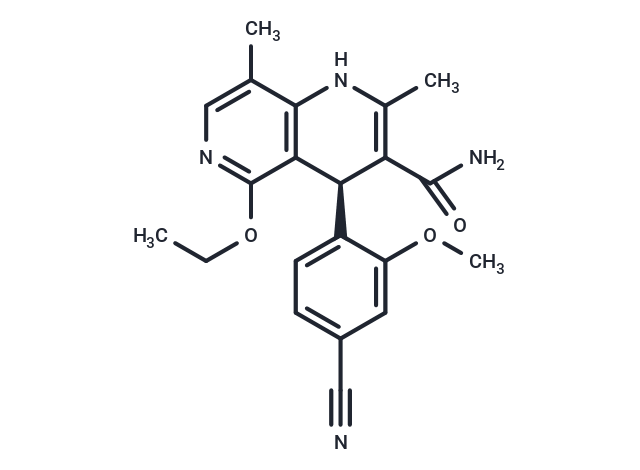Shopping Cart
Remove All Your shopping cart is currently empty
Your shopping cart is currently empty
Finerenone (BAY-948862) is a nonsteroidal antagonist of the mineralocorticoid receptor (MR) (IC50=18 nM) with selective and oral activity. Finerenone is used in the treatment of patients with chronic kidney disease with type 2 diabetes.

| Pack Size | Price | USA Warehouse | Global Warehouse | Quantity |
|---|---|---|---|---|
| 1 mg | $31 | In Stock | In Stock | |
| 5 mg | $74 | In Stock | In Stock | |
| 10 mg | $116 | In Stock | In Stock | |
| 25 mg | $232 | In Stock | In Stock | |
| 50 mg | $374 | In Stock | In Stock | |
| 100 mg | $597 | In Stock | In Stock | |
| 200 mg | $678 | In Stock | In Stock | |
| 500 mg | $995 | In Stock | In Stock | |
| 1 mL x 10 mM (in DMSO) | $82 | In Stock | In Stock |
| Description | Finerenone (BAY-948862) is a nonsteroidal antagonist of the mineralocorticoid receptor (MR) (IC50=18 nM) with selective and oral activity. Finerenone is used in the treatment of patients with chronic kidney disease with type 2 diabetes. |
| Targets&IC50 | CHO cells-K1 cells:16 nM, Mineralocorticoid receptor:18 nM, HEK293 cells:58 nM |
| In vitro | METHODS: Human smooth muscle cells SMC and human endothelial cells EC were treated with aldosterone (1-50 nM) and Finerenone (1-10 nM) for 24 h. Cell proliferation was detected by BrdU incorporation assay. RESULTS: After stimulation with aldosterone, the proliferation rate of SMC increased significantly. Although treatment with 1 nM concentration of Finerenone showed a clear tendency to decrease the SMC proliferation rate, 10 nM Finerenone adequately and significantly blocked aldosterone-induced SMC proliferation. However, aldosterone did not affect EC proliferation in vitro, nor did Finerenone. [1] METHODS: HK-GFP-hMR cells were treated with aldosterone (10 nM) and Finerenone (1 µM) for 3 h. The gene expression levels were measured by RT-qPCR. RESULTS: Finerenone was effective in antagonizing some aldosterone-induced genes. [2] |
| In vivo | METHODS: To investigate the effects on vascular remodeling after acute vascular injury, Finerenone (1-10 mg/kg) was administered orally once daily for 21 days to wire-induced femoral artery dilated C57BL/6 mice. RESULTS: Finerenone treatment inhibited intimal and intermediate cell proliferation after wire-induced injury in mouse femoral arteries at 10 days post-injury and attenuated the formation of neoplastic intimal injury at 21 days post-injury. [1] |
| Synonyms | BAY94-8862, BAY-94-8862, BAY-948862, BAY948862, BAY 94-8862, BAY 948862 |
| Molecular Weight | 378.42 |
| Formula | C21H22N4O3 |
| Cas No. | 1050477-31-0 |
| Smiles | CCOc1ncc(C)c2NC(C)=C([C@@H](c3ccc(cc3OC)C#N)c12)C(N)=O |
| Relative Density. | 1.29 g/cm3 (Predicted) |
| Storage | keep away from direct sunlight,keep away from moisture,store at low temperature | Powder: -20°C for 3 years | In solvent: -80°C for 1 year | Shipping with blue ice/Shipping at ambient temperature. | |||||||||||||||||||||||||||||||||||
| Solubility Information | DMSO: 60 mg/mL (158.55 mM), Sonication is recommended. H2O: Insoluble | |||||||||||||||||||||||||||||||||||
| In Vivo Formulation | 10% DMSO+40% PEG300+5% Tween 80+45% Saline: 6 mg/mL (15.86 mM), Solution. Please add the solvents sequentially, clarifying the solution as much as possible before adding the next one. Dissolve by heating and/or sonication if necessary. Working solution is recommended to be prepared and used immediately. The formulation provided above is for reference purposes only. In vivo formulations may vary and should be modified based on specific experimental conditions. | |||||||||||||||||||||||||||||||||||
Solution Preparation Table | ||||||||||||||||||||||||||||||||||||
DMSO
| ||||||||||||||||||||||||||||||||||||
| Size | Quantity | Unit Price | Amount | Operation |
|---|

Copyright © 2015-2025 TargetMol Chemicals Inc. All Rights Reserved.